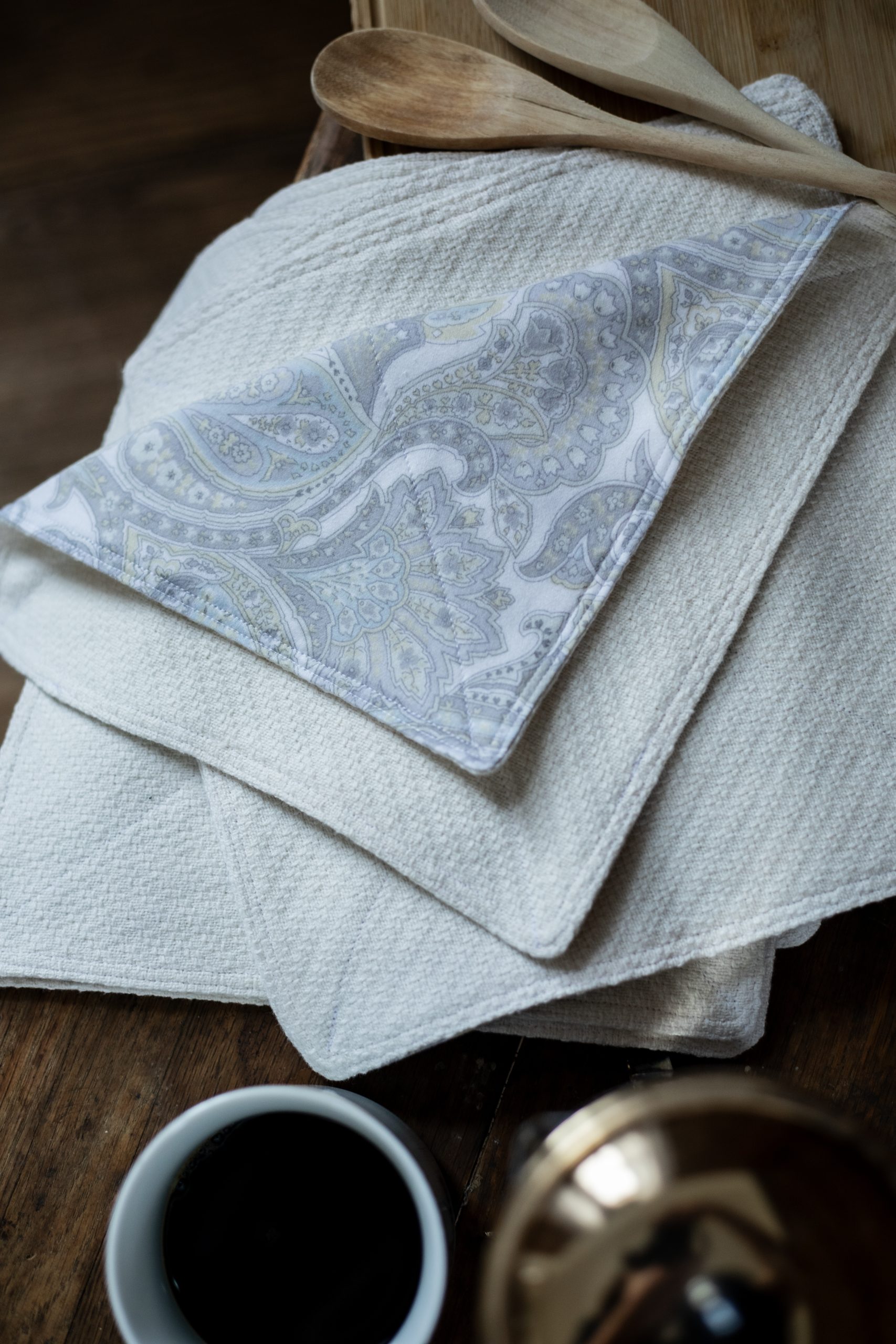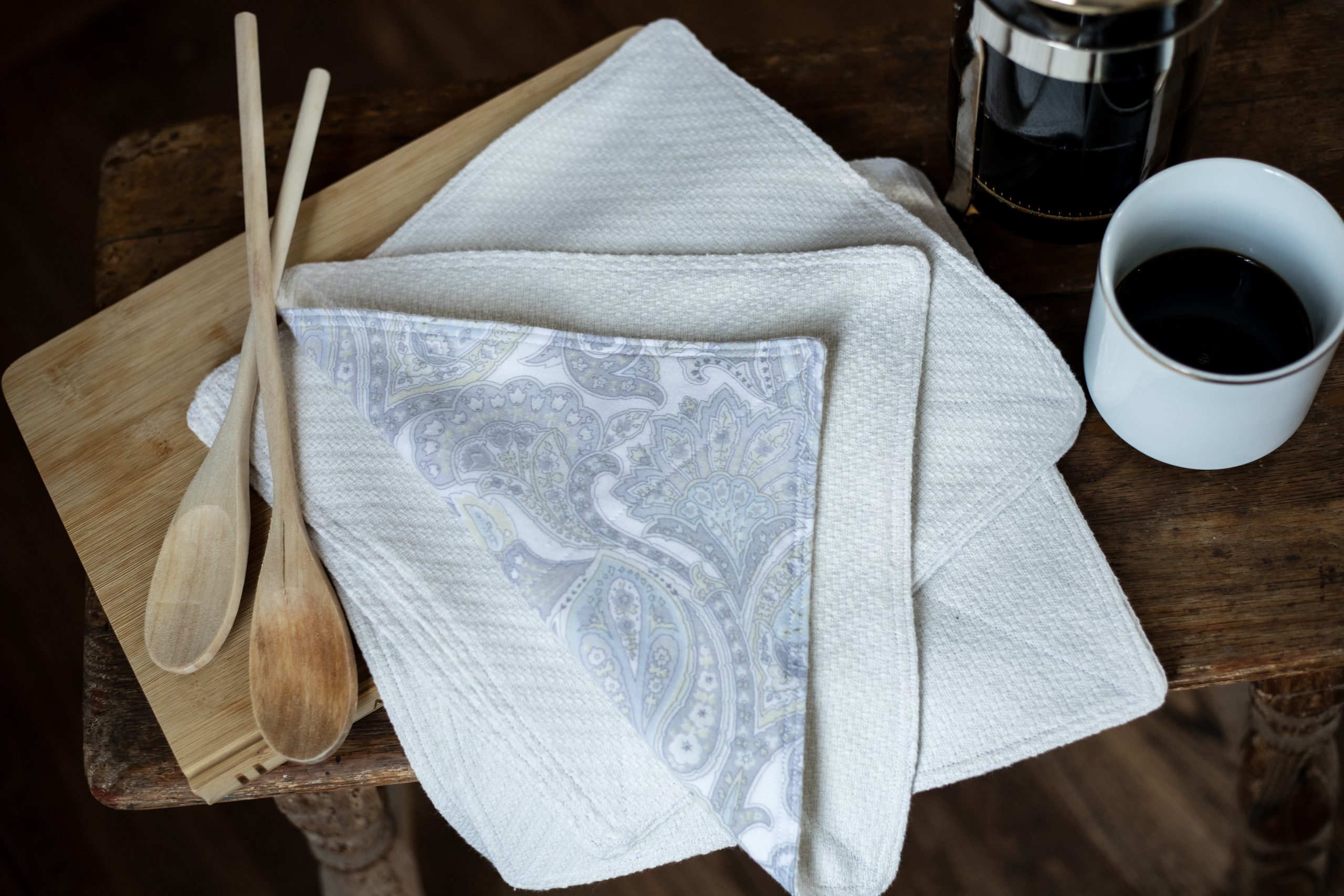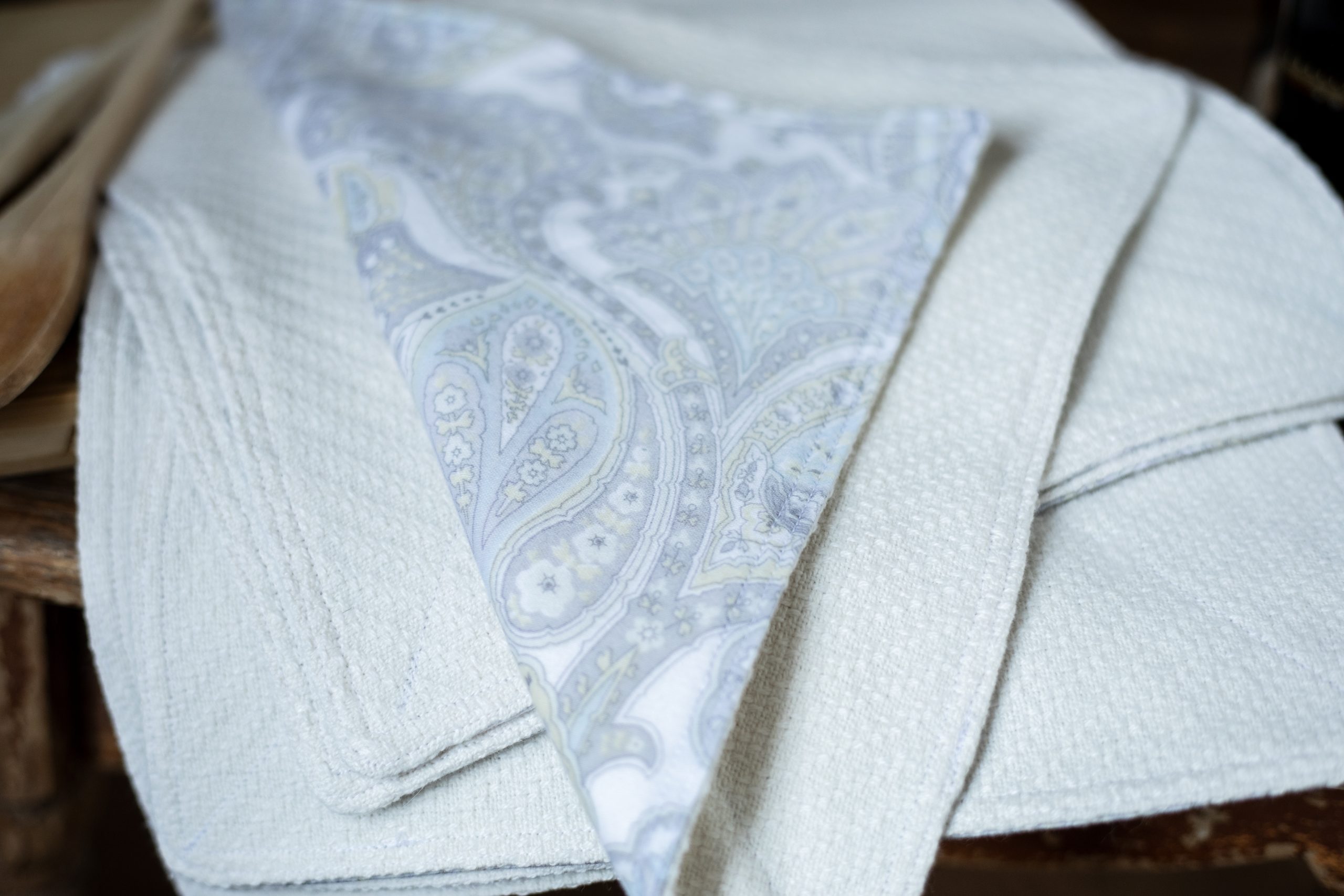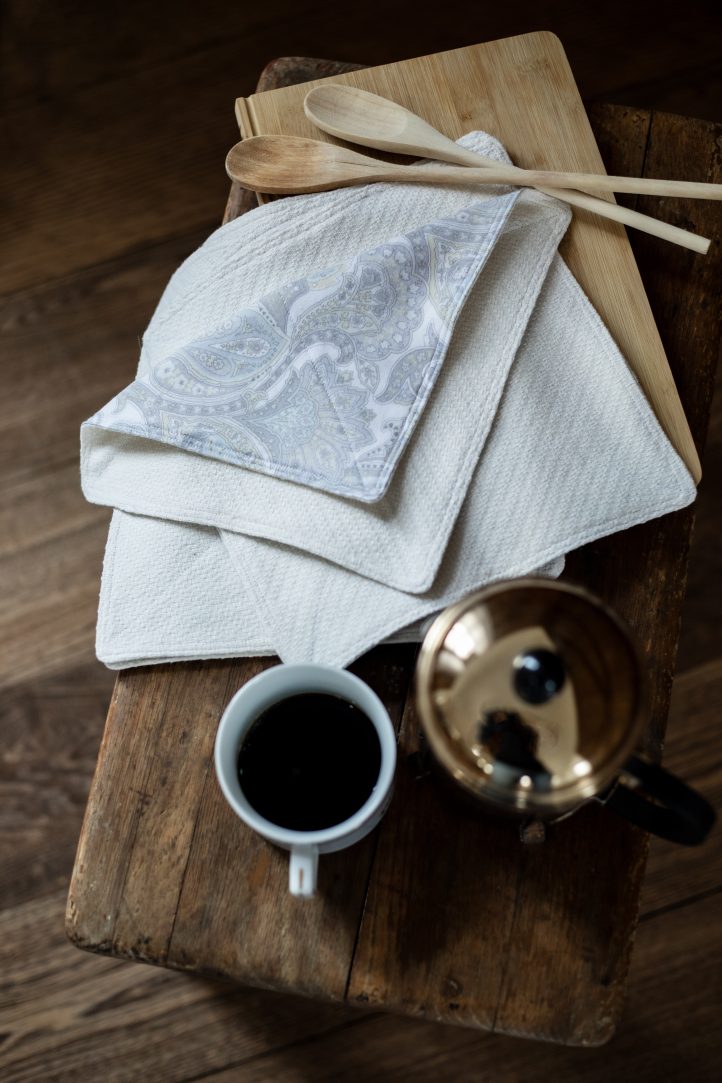
The time has come to ditch single-use paper towels! Learn how to make your own reusable paperless towels with Dana Rebmann in her fascinating article and sewing pattern combo. Dana walks you through why and how to make the switch to paperless towels, as well as how to sew your own with her beginner sewing pattern. Eco-friendly sewing has never been easier.
Paperless Towels: Making the Switch
Thinking about making the switch from paper towels to paperless ones? Do it…today. I made the switch 6 months ago and love it. I had a ton of questions when I first considered ditching paper towels like: what fabric is best, what size should I make, how do I store clean and dirty towels? Below are tips and suggestions to help your transition be a smooth one.
Paperless towels are more than just rags. They can be utilized as napkins, dishcloths, spill rags, wash cloths, make-up removers, rags for cleaning the bathroom and more. Switching to paperless towels will save you money, reduce waste and, my personal favorite reason to use them, they will make cleaning more fun. Here are several great reasons to make the switch. You can:
- Eliminate or severely reduce paper towel usage.
- Wash and reuse them.
- Repurpose clothing or fabric already on hand.
- Salvage clothing that shows some wear and tear.
- Use remnants and scraps from other sewing projects.
- Graduate fabrics from nursery to household use.
- Support others in need by purchasing fabric from charity thrift store.
- Make these as gifts.
Paperless towels can be made from new fabrics, repurposed fabrics, or slightly worn fabrics. New fabrics allow you to coordinate the paperless towels with your decorating or add a festive flair for the holidays. I recommend that you select fabrics that will make you happy and happy to clean.
SIZE AND USES FOR PAPERLESS TOWELS
- What size should you make your paperless towels? That depends on how you plan to use them. If you want face scrubbies, then make them smaller. If you are drying dishes, then make them larger.
- As a point of reference, a standard paper towel is approximately 11” x 12” and select-a-size is approximately 5 1/2” x 12”.
- There are all kinds of uses for paperless towels. Many people use a specific size, fabric, and color to identify how and where paperless towels should be used. For instance, paperless towels for the kitchen will be a different size and color than those used to clean the bathroom.
Here are some ways people use paperless towels:
- Kitchen (dishcloth, spill clean-up, drying dishes, drying your hands)
- Dining (napkins)
- Bathroom (face scrubbies, make-up remover, washcloths)
- Garage and Auto Care
- Pet Care and Clean-up
- Child Care
- Household Cleaning (dusting, sanitizing)
- Support of a Hobby (cleaning a bicycle or to take along fishing)
- Other
FABRIC FIBER TO USE
Most people use cotton flannel or terry cloth cotton when making paperless towels, but when selecting a fabric, consider these three factors: absorbency, lint, and antibacterial properties. For paperless towels that will have a single use between cleanings like a spill rag, a cotton cloth works great. If the paperless towel will be used multiple times between washing like a dishcloth, consider bamboo viscose for its potential antibacterial properties. If the paperless towel will be used to wipe mirrors or electronics, polyester is a great lint free option.
- Bamboo Viscose (absorbent/potentially antibacterial and anti-fungal)
- Birdseye Cotton/Diaper Utility (most absorbent)
- Cotton (absorbent)
- Flannel Cotton: single sided or double sided (very absorbent)
- Microfiber (slightly absorbent, lint free)
- Polyester (not absorbent, lint free)
- T-Shirt Cotton (fairly absorbent)
- Tea Towel Fabric Cotton and/or Linen (absorbent)
- Terry Cloth Cotton (fairly absorbent)
Upcycle fabric that you already have around the house or pick some up at the second-hand store. Read the tag and look for fabrics with your desired fiber content. Items you can upcycle include:
- Baby Receiving Blankets
- Flannel Shirts
- T-Shirts
- Pajamas and Other Clothing
- Towels
- Flour Sack/Tea Towels
- Bed Sheets, Pillow Cases, Blankets
LAUNDERING PAPERLESS TOWELS
Read the care label on the fabric you’re using. Below are some general principles:
- Remove excess dirt from towels prior to washing.
- Air dry wet dirty towels so they don’t attract mold and mildew while they wait to be washed.
- Wash like fabrics together.
- Do not use fabric softener. It reduces the fabric’s ability clean and reduces absorbency.
Cotton:
- Wash lightly soiled paperless towels with your regular washing.
- Wash heavily soiled paperless towels in hot water to help remove stains and germs.
- If towels begin to smell, wash twice: first washing add 1 cup vinegar, second washing add 1/2 cup baking soda.
- Some people prefer to make their paperless towels with white cotton fabric so they can wash them with bleach.
Bamboo, Microfiber, Polyester:
- Wash separately (especially polyester towels so they remain lint free).
- Wash in cold or warm water on gentle cycle with gentle detergent (not stain removing detergent) and tumble dry low.
- If microfiber or polyester towels begin to smell, add 1 Tablespoon vinegar to washing.
CHOOSING A THREAD
- You can use any thread. However, polyester is recommended as it won’t shrink and it resists stains.
- Choose a thread to match your fabric to hide the seaming or use a contrasting color to make it stand out.
STORING CLEAN AND DIRTY PAPERLESS TOWELS
The reason traditional paper towels are so popular is because they are often quick and easy to reach and dispose of. Therefore, when making the switch, think about how to make the paperless towels just as easy to use. The biggest complaint about paperless towels is dirty towels are left lying around making the house look cluttered and messy. The second biggest complaint is that no one wants to walk to the laundry basket which may be on a different level of the house or too many steps away.
Think through storage solutions that will work for your home and family. Here are popular options:
Clean Towels in the Kitchen:
- In a drawer
- On the counter
- Under the counter
- In a basket or bowl
- Hanging from a hook
- Rolled on a paper towel holder
Dirty Towels in the Kitchen:
- Basket under the sink
- Wet bag hanging from the oven door
- Small bin near the trash can
- Drying on a hook or towel bar
The list above offers suggestions for paperless towels in the kitchen, but consider how you want to store then in other areas around the house as well.
A note of caution: You don’t want dirty towels to be confined to a dark wet location that will allow germs to grow. If you are using a wet bag, be sure to launder it and the towels frequently.
MAKING THE SWITCH
My advice to you if you’re thinking about making the switch to paperless towels – go for it! Just be honest and creative about solutions that will work for you and your household. Will you take the time to roll paperless towels together to store on a paper towel holder? Or, do you want to just throw them in a pile in a drawer? Do you like tidy folded clothes at arm’s reach near the kitchen sink in a basket? What solutions will work for you and your household?
Keep in mind that making the switch doesn’t mean you have to eliminate traditional paper towels completely. It simply means that you make them less convenient so they are only used for jobs they are better suited for like wiping up grease. Consider storing them under the kitchen sink or in a storage cabinet, away from easy access.
Communicate your expectations to the rest of the household. Explain your reasons, demonstrate uses, talk through expectations and get buy in. Make the transition fun by taking special requests for fabric and size preferences.
The switch to paperless towels can be fun and easy or it may take time and patience. For best results, find realistic solutions that will work for you, your lifestyle and living arrangements.
How to Sew Your Own Upcycled Paperless Towels
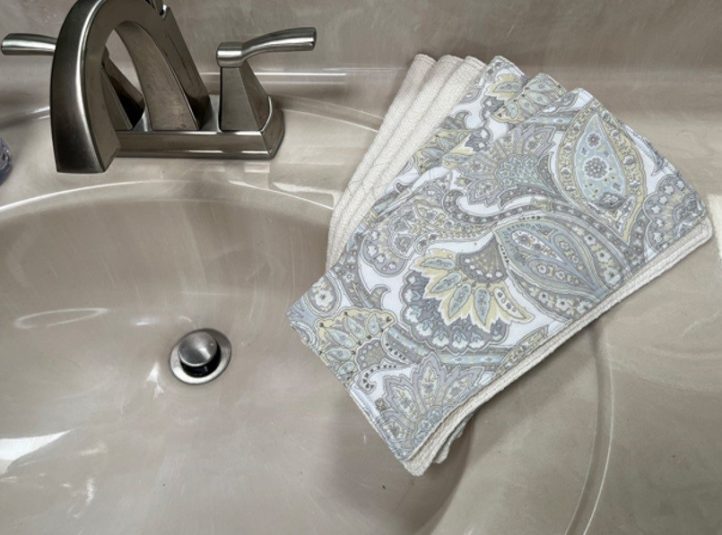
Skill Level: Beginner
Finished Size: 10” x 10”
Time: 2 hours
Seam Allowance: 1/4”
Materials:
- Fabric:
- Paisley cotton bed sheet – cut 1 – 10 1/2” x 10 1/2” – A
- Cream cotton blanket – cut 1 – 10 1/2” x 10 1/2” – B
- Thread: Polyester
Fabric Notes:
- Fabric was sourced from a second-hand thrift store. One side was made from a paisley print cotton bed sheet, the other side a thin cream-colored cotton blanket. Cotton flannel is a popular alternative for this project.
- Back stitch every time you begin and end a section of stitching.
- Polyester thread recommended because of its stain resistance qualities.
Instructions:
- Wash, dry, and iron fabric.
- Cut fabric.
- Tip: Creating a tracing template from paper or a cardboard cereal box makes this step easier.
- A. Cut template to 10 1/2” x 5 1/4”.
- B. Fold fabric in half, place template on fabric, and mark with a fabric pencil.
- C. Cut fabric.
- D. Unfold fabric.
- E. Repeat Steps A-D for Fabric B.
- Tip: Creating a tracing template from paper or a cardboard cereal box makes this step easier.
- Pin A and B right sides together. If using a printed fabric that’s directional, place top sides together.
- Mark a 3” section in the middle of one side that will not be sewn. This will allow you to turn the fabric right side out after sewing around. See diagram below.
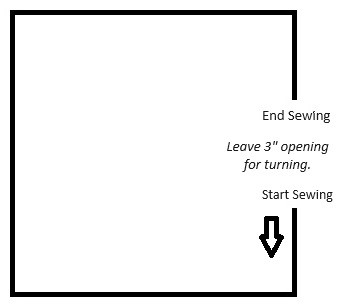
- Place fabric on machine at the beginning of the opening. Sew along outside edge of fabric with 1/4” seam allowance stopping 3” from where you started (the other end of the opening for turning right side out).
- Trim off fabric at corners to about 1/8” from thread stitching, making sure not to cut into stitching. This removes excess fabric in the corners when you turn the fabric right side out.
- Turn fabric right side out.
- Iron paperless towel creating a nice crisp edges and corners.
- Tuck/fold fabric at opening to the inside to match hem. Iron the folds.
- Top stitch around from edge 1/4”. Create a rounded seam at corners by slowly stitching and turning fabric.
- Top stitch again at 1/8” from edge. This creates a double hem. It also sews any portion of the opening that was missed in the 1/4” top stitch in previous step.
- Optional: Sew an X across entire project stitching from corner to corner diagonally. This will help the paperless towel stay flat after laundering.


